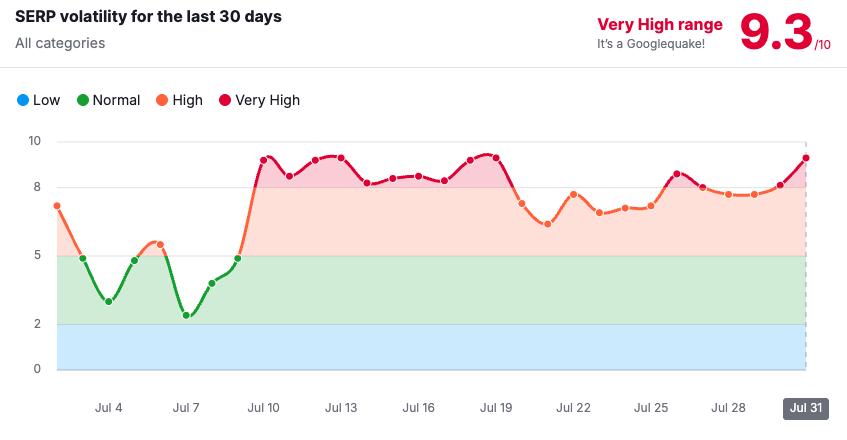The June 2025 update showed a stronger mobile search impact than previous core updates. Mobile ranking adjustments were more prominent than desktop changes. The update reinforces Google's mobile-first indexing priorities and highlights how critical mobile optimisation has become for websites across all sectors.
E-E-A-T signal strengthening
Google enhanced its evaluation of Experience, Expertise, Authoritativeness, and Trust signals. The changes particularly affected Your Money Your Life content areas, including finance, health, and education. Sites demonstrating clear expertise and authority saw improvements, whilst those lacking credible signals faced challenges.
Commercial intent gets smarter recognition
Google hits transactional searches harder than informational ones. They're getting better at understanding what people actually want when they search. Ecommerce sites and service businesses saw bigger ranking changes than blog publishers or news sites.
Content quality bar rises higher
The update increased penalties for thin, heavily templated content while rewarding comprehensive, well-researched material with clear expertise being demonstrated. Publishers investing in depth and quality saw positive movements, reinforcing Google's push towards genuinely helpful content.
Mixed results and typical core update patterns
As is typical of a core algorithm update, reported results on site performance were mixed. Some sites previously negatively affected by the Helpful Content Update reported ranking surges, whilst other sites worsened. Any initial ranking fluctuations, whether positive or negative, have been fully realised by now.
What does the update mean for SEO and marketers?
Core algorithm changes don't target specific sites or individual pages. Instead, they refine how Google evaluates content quality across the entire web. Our advice hasn't really changed from previous updates. You should continue to follow E-E-A-T best practices to ensure your content aligns with Google's definition of helpful search results.
Key areas to focus on:
-
Create original content that genuinely helps users solve problems
-
Audit existing pages to identify improvement opportunities
-
Ensure every piece of content provides clear value
-
Prioritise user experience alongside accurate, helpful information
-
Demonstrate real expertise through detailed, well-researched content
The mobile-first shift represents a significant change from previous updates. Your site must perform brilliantly on phones, not just function adequately. Page speed and usability on mobile devices are now critical ranking factors that can make or break your search visibility.
Remember that Google may take several months to recognise improvements to your content quality and user experience. Consistency and patience are essential as you build authority and trust signals over time. The advice we shared following the March 2025 update remains relevant, but the June update places even greater emphasis on mobile performance and content depth.
Previous core updates
What did the March core update include?
The March Google core update focuses on improving search quality, in a similar manner to previous updates. By prioritising helpful and relevant content and reducing the visibility of low-quality pages, Google aims to provide a more rewarding search experience. Elements of the new update include:
Updates to spam policies
The March update includes spam policies that are tailored to address quickly evolving abusive practices. By taking necessary action, Google will be helping to prevent unoriginal and low-quality spam content to become more common in search results.
Policies for tackling content produced at scale
The latest core update aims to address the practice of producing vast quantities of content in an attempt to boost search rankings. Large-scale content production will come under scrutiny, regardless of whether that content is created by a human, automation, or a combination of the two.
Google also plans to take action against content that has little or no value for a user. They will penalise pages that pretend to answer popular searches but don’t actually say anything helpful.
A new approach to combating site reputation abuse
It is possible for websites to host low quality third-party content in addition to their own helpful content. The end goal is for third-parties to capitalise on the good reputation of the hosting site, which can be misleading to visitors.
From May 5th, Google will now consider very low-value, third-party content that has been produced purely for ranking purposes to be spam. The announcement comes early to allow site owners some extra time to make any necessary changes.
Improvements in countering the abuse of expired domains
Expired domains can be purchased and repurposed with the intention of boosting the search ranking of low-quality or unoriginal content. Users may be led to believe that the new low-quality content is part of the old website, and therefore more trustworthy than it really is. However, as part of the March Google core update these domains will now be considered spam.
What does the update mean for SEO and marketers?
Changes to the core algorithm won't target specific sites or individual web pages. Marketers are encouraged to continue to follow EEAT best practices to help ensure that all content aligns with Google’s definition of a good search result. Some tips include:
-
Prioritising helpful, original content that provides a good user experience.
-
Auditing existing content to identify areas for improvement and ensure every page provides value for users.
-
Focusing on providing a positive user experience with information that is accurate and helpful.
However, it is worth bearing in mind that it may take several months for Google to confirm that your site is producing helpful and reliable people-first content.
How has the recent March update made an impact so far?
If your rankings have shifted recently, the March core update could well be the reason. During the rollout, many websites saw significant ranking volatility. At CTI Digital, we’re monitoring these fluctuations on behalf of our clients. One client experienced a dramatic increase in organic visibility, as their site featured in 4151 AI Overview snippets - increasing from just 437 in the previous month.
Our team will continue to assess any changes and help to ensure our clients are at the forefront of any developments. If your SEO rankings have dropped, get in touch. Our team can carry out an audit and create a clear strategy to help you get back on track.
December 2024 Core Update
Particularly impacted educational and Your Money Your Life (YMYL) sectors:
-
Increased emphasis on authoritative sources and expert credentials
-
Enhanced user experience evaluation
Stricter content quality assessments for educational institutions
August 2024 Core Update
This core update marked a significant shift towards supporting smaller, independent websites:
- Levelled the playing field between large and small publishers
- Reduced dominance of established websites in certain niches
- Improved visibility for high-quality niche content creators
Impact on different industries
Education sector considerations
Educational institutions face unique challenges with core updates because Google treats educational content as "Your Money or Your Life" (YMYL) material. This means the search engine applies much stricter quality standards, recognising that poor educational content can genuinely harm people's lives and opportunities.
The biggest hurdle for educational sites is proving authority. Google wants to see that real experts are creating your content, not just marketing teams writing about subjects they don't understand. If you're publishing research or academic content, make sure qualified authors are clearly credited with detailed bios that establish their credentials. Surface-level articles that skim over complex topics won't cut it anymore. Google expects comprehensive coverage that actually educates rather than just attracts clicks.
User experience has become particularly important for educational sites, too. Students and researchers often access content on mobile devices, so if your site doesn't work brilliantly on phones, you're failing your audience, and Google knows it.
Charity sector considerations
Charities need to demonstrate genuine impact and transparency to perform well in Google's post-update environment. Focus on clearly communicating your mission with specific examples of the work you do and the outcomes you achieve. Vague impact statements don't build the authority Google looks for.
Trust signals are particularly important for charitable organisations. Include detailed contact information, annual reports, and testimonials from actual beneficiaries. Be transparent about how donations are used and what programmes you run. Google values organisations that can clearly explain their work rather than just make emotional appeals for funding.
Building community connections helps establish local authority signals. Engage with local media, partner with other organisations, and document your community involvement. These authentic relationships contribute to how Google evaluates your organisation's credibility.
Tourism and leisure sector considerations
Tourism businesses should focus on providing genuinely helpful information that helps people plan their experiences. Instead of generic promotional content, create detailed guides about locations, activities, and logistics. Think about the practical questions visitors ask and answer them comprehensively.
Mobile experience is crucial for tourism sites since people often research and book while travelling. Ensure your site works perfectly on phones, loads quickly, and provides easy access to essential information like contact details, directions, and booking options.
Keep your content current and relevant. Tourism is dynamic, so regularly update information about availability, seasonal changes, and current conditions. Sites with fresh, accurate information perform better than static brochure-style websites that never change.
eCommerce implications
If you run an eCommerce business, you likely felt the impact of the June 2025 core update more than most. Google's improved commercial intent recognition now better understands when people are actively shopping. Combined with AI Mode, it's prioritising sites that provide comprehensive product information over those optimising purely for rankings.
eCommerce businesses saw bigger ranking fluctuations than informational sites during this update. If your site has thin product descriptions or templated content, you probably struggled. Google's enhanced algorithms now reward detailed product specifications, authentic customer reviews, and clear trust signals like return policies and security badges. Sites investing in comprehensive, helpful product information saw improvements.
Getting expert support
Core updates present both challenges and opportunities for businesses serious about search visibility. At CTI Digital, our team of 150+ specialists monitors algorithmic changes closely, helping ambitious brands adapt effectively to Google's evolving requirements.
We've successfully guided clients through multiple core updates, from dramatic visibility increases to technical optimisation improvements. Our approach combines deep technical expertise with practical business understanding, ensuring your SEO strategy evolves alongside Google's algorithms.
Need help navigating core updates? Our SEO specialists can audit your current performance, identify optimisation opportunities, and develop strategies that maintain visibility regardless of algorithmic changes.


